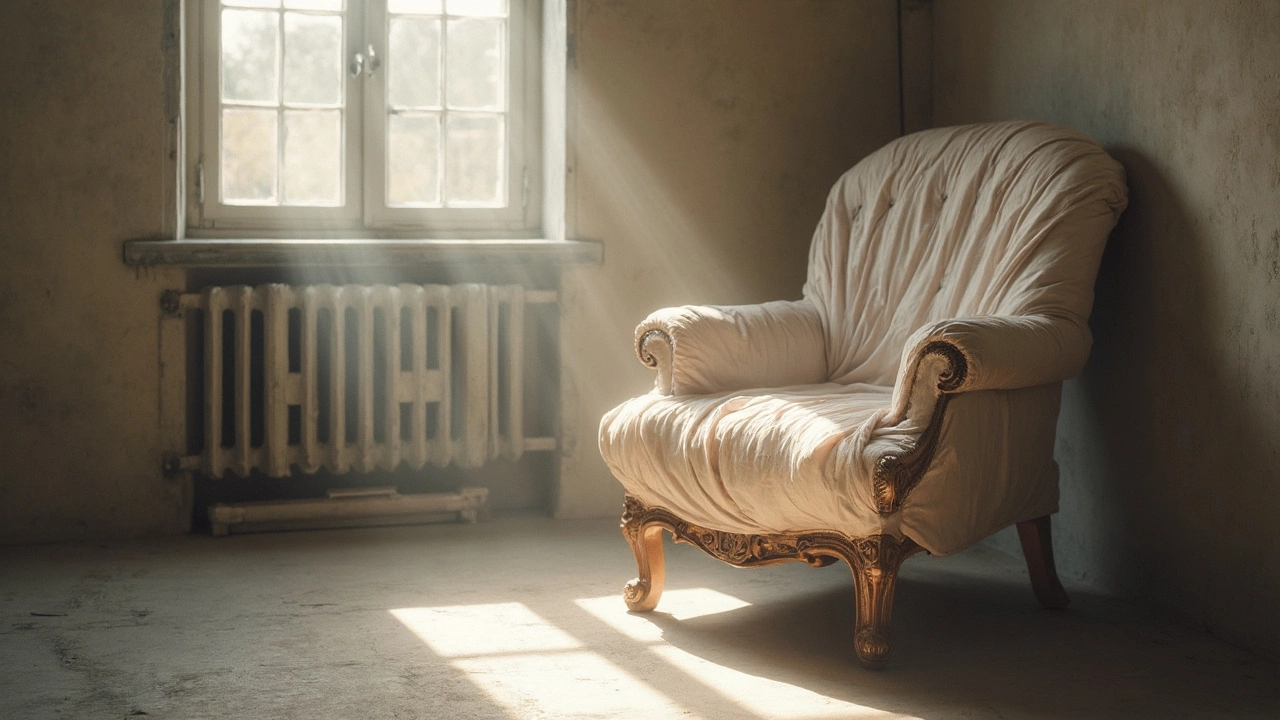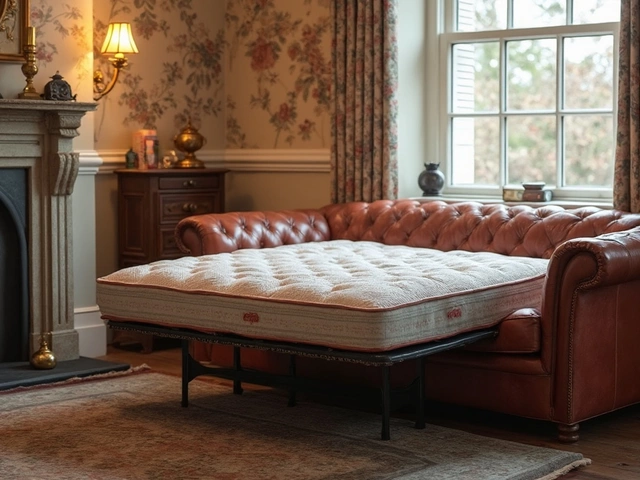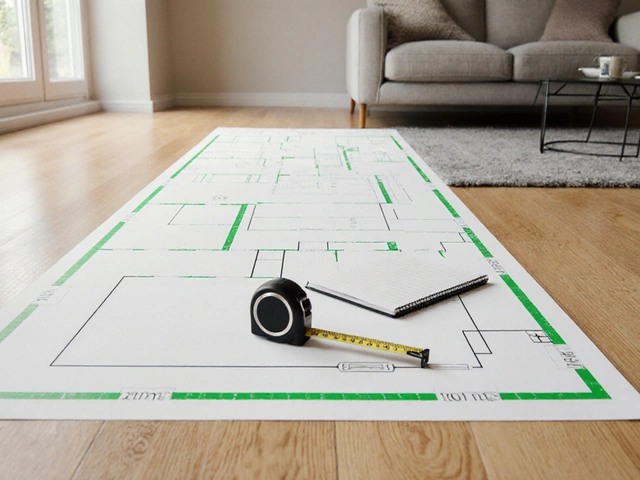Ever tossed your furniture into a storage container and crossed your fingers it wouldn't come out resembling a science experiment? It’s a valid concern, especially when mould loves a good dark, damp space. If you’re not careful, your prized sofa could end up with an unwanted greenish layer of fuzz.
Mould, those sneaky spores, thrive when the conditions are right—think moisture, lack of ventilation, and organic material to feast on. That wooden dining table? Yeah, it’s on the menu. But don’t worry, storing furniture doesn’t have to be a game of chance.
To keep your pieces safe, it’s all about managing the environment inside the storage container. This means keeping humidity levels in check and ensuring good ventilation. Investing in some moisture absorbers and taking a few extra prep steps before sealing the deal could make all the difference. The aim is to keep it dry and breathable, which can save your furniture from turning into mould's next meal.
In the sections that follow, I'll walk you through everything you need to know to keep your furniture free from mould—without crossing your fingers!
- Understanding Mould Growth
- Choosing the Right Storage Container
- Controlling Humidity Levels
- Ventilation and Airflow
- Preparing Furniture for Storage
- Mould Prevention: Practical Tips
Understanding Mould Growth
When it comes to storing furniture, understanding how mould grows is half the battle. It loves humid, damp environments, and a storage container could provide just that if you’re not careful. Mould spores are everywhere, and once they detect moisture, they settle in and grow on surfaces like fabric and wood.
Why does this matter for furniture? Well, if your storage conditions are like a mould paradise—dark and wet—you could be in trouble. Anything organic-like wood, upholstery, or leather is a perfect host for these pesky spores. They don't just ruin the look; they can also weaken the structural integrity of pieces over time.
What Mould Needs to Thrive
Mould requires moisture, warmth, and a food source. While you can't help the latter since furniture materials are the perfect food, controlling moisture and temperature is doable. Ideally, relative humidity should be kept below 60%. More than that, you risk creating a friendly environment for mould.
| Condition | Optimal for Mould Growth |
|---|---|
| Humidity | Above 60% |
| Temperature | 15 - 30 °C |
| Airflow | Poor or stagnant |
Monitoring these elements can help keep those spores at bay. A hygrometer is a handy tool for measuring humidity in your storage container, providing you with peace of mind.
How to Spot It Early
Spotting mould early is a game-changer. It usually appears as spots or discoloration on your furniture, sometimes accompanied by a musty smell. Regular checks can save you from costly damages. If you catch it right away, a simple clean-up can do the trick, preventing further spread.
In essence, storing furniture effectively is about creating an unwelcome environment for mould by controlling moisture and improving ventilation. In the long run, it's all about prevention, and that starts with understanding what makes mould tick.
Choosing the Right Storage Container
Picking the perfect storage container isn't just about how much stuff you can cram into it. To keep your furniture from getting mouldy, you've got to think about a few key factors. Let’s break it down.
Materials Matter
A container made of heavy-duty steel or sturdy plastic can be a good call. These materials are less prone to leaks and provide a solid barrier against the elements. Avoid old, worn-out containers as they might have cracks or holes letting moisture seep in, putting your furniture at risk.
Size and Space
Size matters, but not in the way you might think. Sure, you need enough room for your stuff, but packing it too tight can restrict airflow, which is a big no-no for mould prevention. Go for a size that allows a little breathing space around your items.
Weatherproof Features
Look for containers with features like sealed doors and raised floors. These help keep rain out and any sneaky puddles from forming inside. If water can’t get in, you’re already ahead in the battle against mould.
Security and Location
While it’s not directly about mould, consider the security and location of your storage. A well-maintained facility with controlled access not only keeps your furniture safe from theft but often indicates better climate control too. Pick a spot that's not prone to flooding.
Here’s a neat little insight—data shows that containers parked on a stable concrete surface, away from direct soil contact, tend to have a lower percentage of moisture issues.
- Rainproof cover for extra protection.
- Consider containers with built-in ventilation features.
- Regularly check and maintain the storage unit
By thinking through these elements before plopping your furniture into storage, you're setting yourself up for success. It’s about being proactive rather than hopeful. After all, mould prevention starts with your choice right at the beginning, with your storage container. So, it's worth taking a minute to consider all the factors and what works best for your specific situation.
Controlling Humidity Levels
Humidity is the arch-nemesis of anything stored, especially when it comes to furniture. Keeping your furniture in great shape in a storage container means getting that humidity under control, so let’s dive into how you can do just that.
Humidity Say Hello to Moisture Absorbers
One of the easiest ways to tackle humidity is using moisture absorbers. You can grab these from most hardware stores. Place them strategically around the container. A little foresight can save you a furniture disaster.
Moisture absorbers come in many forms, such as silica gel packs or activated charcoal. These little guys soak up excess moisture, keeping both furniture storage power and content dry.
Regularly Check and Replace
These guys aren't forever. Over time, they lose their absorbency, so ensure you check and replace them every few months. Think of it as swapping out old batteries.
Frequent Climate Monitoring
Ever heard the saying, 'What you don’t know can’t hurt you?' Well, it doesn’t apply here. Use a hygrometer inside your container to track humidity levels. Ideally, keep it below 50%. Too high, and moisture’s winning. Too low, and you might face dry air issues. Talk about finding balance!
Consider a Dehumidifier
If you’re still struggling with moisture, a small dehumidifier can be a game-changer for your storage furniture. It may require a power source but can make all the difference in a humid climate. It pulls the moisture right out of the air inside the container.
Watch the Weather
The weather outside does influence what happens inside. In rainy seasons, consider tightening the routine on moisture control. During dry spells, you might ease up just a tad.
Keeping humidity levels in check means less stress and a better homecoming for your stored items. It sounds like effort, but knowing your prized pieces won't look like science projects is totally worth the extra step!

Ventilation and Airflow
When it comes to furniture storage in a storage container, ventilation could be your best friend. It's all about keeping air circulating to prevent moisture buildup. Containers can quickly become moisture traps, especially if they're parked in a humid climate or just after a rainy day.
Think of it like this: you wouldn't want to spend a day in a room without any airflow, right? Your furniture feels the same way. Without proper airflow, you end up with stagnant air and that's when mould says, "Hey, I love this place!"
How to Improve Airflow
- Install Vents: Consider adding vents to your storage container. Just like houses have ventilation systems, a few strategically placed vents can make a significant difference. It allows fresh air in and pushes the stale, moist air out.
- Use a Fan: A small, battery-operated fan can do wonders inside a container. Set it up on a timer to keep air moving, which helps in cutting down moisture levels.
- Open the Doors: Whenever you get the chance, pop open those container doors. Let the sunlight and fresh air blow through; it’s free and effective.
Why Ventilation Matters
Proper ventilation and airflow not only keeps mould at bay but also preserves the condition of your furniture. Trapped moisture can seep into materials, causing things like warping in wood and bad smells that are hard to shake.
Believe it or not, a study showed that maintaining good airflow can reduce the chances of mould growth by up to 30%. So, prioritizing airflow is a practical way to save yourself from headaches later on.
In short, ventilation and airflow in a storage container shouldn't be overlooked. It’s a simple precaution that can save you from a mouldy disaster.
Preparing Furniture for Storage
Before you stash your beloved pieces into a storage container, there are some crucial steps to make sure they come out in one piece and mould-free. It’s all about preparation—think of it like giving them a cozy coat for the cold months.
Clean Thoroughly
First things first, you gotta clean. Dust and dirt are like a welcome mat for mould. Wipe down wooden surfaces with a gentle cleaner, and don’t forget the undersides. For fabric upholstery, consider a thorough vacuum. Using a cleaner that contains an anti-microbial agent could add an extra layer of protection.
Disassemble If Possible
Less space means less chance for air to get trapped. If your furniture can be taken apart, do it. This includes removing legs from tables or taking shelves out of bookcases. It makes handling easier and minimizes the risk of damage.
Protection with Covers
While it might seem fancy, wrapping your furniture in breathable covers, rather than plastic, keeps it dry. Plastic can trap moisture, creating a mould-friendly environment. Moving blankets or cloth sheets are your go-to, letting the air flow naturally.
“Proper packaging and covering play a vital role in furniture preservation. It’s simple but highly effective,” says Alex Tanner, storage expert at KeepSafe Storage Solutions.
Elevate from Ground
Dampness can seep up from the floor, so make sure to elevate furniture pieces off the ground. Wooden pallets or shelves work great for this; they reduce direct contact with any potential moisture.
Use Moisture Absorbers
Toss in a few moisture absorbers or silica gel packs inside the container. They help keep humidity in check, giving mould fewer reasons to move in. If you’re a bit handy, a homemade dehumidifier using charcoal briquettes can be an option too.
These prep steps not only keep furniture moisture-free but also extend its lifespan even when tucked away. So, when you're all set with furniture storage, you'll know they're safe, sound, and ready to shine again.
Mould Prevention: Practical Tips
Want to keep your furniture storage nightmare-free? Let's dive into some easy steps to stop mould in its tracks.
Choose the Right Container
First off, make sure your storage container is the best fit. Opt for one that's designed to be waterproof and airtight. This is your first line of defense against moisture creeping in.
Control Humidity Levels
Humidity is mould's best friend. To cut their friendship short, use moisture absorbers like silica gel packs or dehumidifiers inside the container. Aim for humidity levels below 60% to stay safe.
Ventilation and Air Circulation
A little airflow goes a long way. Open your container occasionally to let fresh air in, and consider placing your containers on pallets if possible, allowing air to circulate underneath.
Furniture Preparation Tips
- Clean thoroughly: Before storage, clean your furniture well. Dust and dirt can retain moisture, so a good wipe-down is essential.
- Disassemble if possible: It’s easier to store and allows better airflow between pieces.
- Wrap with breathable material: Use cotton sheets or furniture covers to protect from dust, and stay away from plastic which traps moisture.
Regular Checks
Don’t let your storage container become “out of sight, out of mind.” Check it periodically to catch any moisture problems early. It’s easier to fix a small issue than deal with a mould mess.
Keep Items Elevated
The ground can be a source of moisture. Keeping furniture off the floor using pallets or shelves helps prevent contact with any potential water seeping in.
These simple guidelines can save you a lot of headaches. Keep an eye on moisture control and stay vigilant, and your furniture will thank you by staying mould-free.





